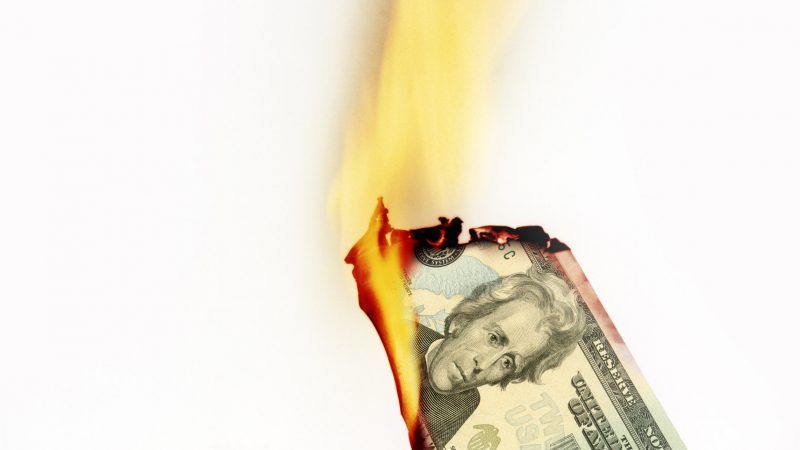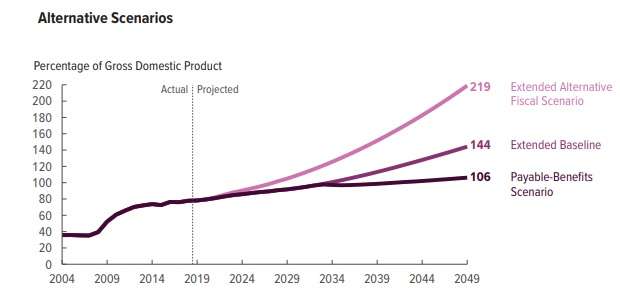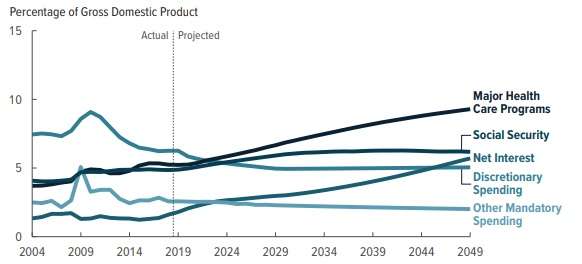Man, This CBO Report About 'Unprecedented' Debt Levels Is a Bummer
The national debt will hit 140 percent of GDP before the end of the 2040s, and that's the optimistic scenario.

The national debt will hit "unprecedented levels" in the coming decades, soaring well above the record highs set during World War II and reaching nearly one-and-a-half times the size of the entire U.S. economy by 2049, the Congressional Budget Office (CBO) projected in a report released Tuesday.
And that's the optimistic view.
The CBO says the national debt will hit 144 percent of gross domestic product (GDP), a rough estimate for the overall size of a country's economic output, within 30 years, even if planned spending cuts materialize next year and even if Congress repeals the 2017 tax cuts in 2026, as planned. Neither of those developments should be treated as a sure bet—and, indeed, Republicans have admitted that the planned expiration of those tax cuts was nothing more than a gimmick designed to favorably influence the CBO's analysis of the Tax Cuts and Jobs Act.
(Actually, the numbers are worse. That's because the CBO is looking only at debt held by the public, which excludes the portion of the national debt that's held as internal loans between different parts of the federal government. For the CBO's purposes, the current national debt is about 78 percent of America's GDP, though including government-held debt puts the figure above 100 percent already.)
If current tax and spending policies remain in place, the national debt will soar to 219 percent of GDP by 2049, the CBO estimates.
The CBO's projections assume that Social Security and Medicare benefits are paid in full, even if there are insufficient resources in the trust funds associated with each program. On the current trajectories and under current law, however, both programs would have to institute benefit cuts within the next two decades. Social Security is on pace to hit insolvency in the mid-2030s, at which point benefits would be reduced by about 20 percent. One of the trust funds within Medicare is on track to become insolvent and unable to pay out full benefits by 2026, according to the programs' trustees.
If those programs are limited to paying out only what they take-in, it would reduce the long-term deficit to merely 106 percent of GDP, according to the CBO.

Under any of those scenarios, it should be obvious that the national debt is becoming a major crisis for the United States—although you wouldn't know it by surveying the current political climate, which is almost completely devoid of deficit hawks. Republicans seemingly stopped caring about the size of the national debt as soon as President Donald Trump was elected, and a whole slew of Democrats are now seeking the White House while promising to spend billions or trillions more—often without any coherent plan for how to pay for their agendas, which translates into an implicit promise of higher deficits and more debt.
"The prospect of such large deficits over many years, and the high and rising debt that would result, poses substantial risks for the nation and presents policymakers with significant challenges," said CBO director Phillip Swagel in a statement.
As the national debt climbs, so too will annual budget deficits. The current year's projected deficit of 4.2 percent of GDP will increase to 8.7 percent by 2049 if current policies are followed—in other words, if the tax cuts are allowed to expire and planned spending cuts occur. Under the alternative scenario, in which the national debt hits 219 percent of GDP, America would be running annual budget deficits of more than 15 percent of GDP by the end of the 2040s.
And, sure, 2049 might sound like a long way off. But it's really not. It's as far into the future as the fall of the Berlin Wall is in the past. If the CBO's projections are accurate, it means the national debt will roughly double between now and the time when most millennials will be retiring.
One of the major problems created by the growing mountain of debt is paying for it. That might sound obvious enough, but one of the major drivers of the long-term debt problem is the interest on the debt itself, according to the CBO's projections. Discretionary spending is expected to be mostly flat—actually, it's likely to decline a little—relative to GDP over the next three decades, but the growing cost of the debt and the increasing cost of entitlement programs are real problems.

This is also one area in which there is a tremendous amount of uncertainty in the CBO's projections. If the interest on the national debt increases—as many observers believe it will at some point, as it becomes increasingly obvious that America has more debt than it can afford—the overall cost of paying down the debt will grow.
The CBO assumes that the interest rate on the debt will never rise above 4.2 percent—well below rates paid as recently as the 1990s. "Many economists believe rising debt will raise interest rates," says Brian Riedl, a senior fellow at the Manhattan Institute, and the author of a plan to hold the debt in check at barely less than 100 percent of GDP. He estimates that every 1 percent rise in interest rates would add $13 trillion in interest costs over 30 years.
"So there is massive interest rate risk in these projections," he says. "Rising rates will bury us."
The national debt is "a glaring vulnerability" for America's long-term national security, warned Maya MacGuineas, president of the nonpartisan Committee for a Responsible Federal Budget, in an op-ed published this week. If China were to sell-off a sizable portion of the U.S. Treasury bonds it owns—and it owns more than $1 trillion of them—the resulting shake-up could easily trigger a rise in interest rates. Even just a 1 percent increase would cost the United States more next year than we currently spend on the entire U.S. Army, MacGuineas pointed out.
"We don't know whether China will go as far as to weaponize their Treasury holdings," she added, somewhat ominously. "Maybe they won't. Or maybe they will wait until we are in a recession, or until they want to invade Taiwan."
And if the debt crisis could arrive at any moment, well, there's no need to wait until the CBO's projections turn into reality. The debt crisis is already here. Congress, and Trump, should start acting accordingly.


Show Comments (98)